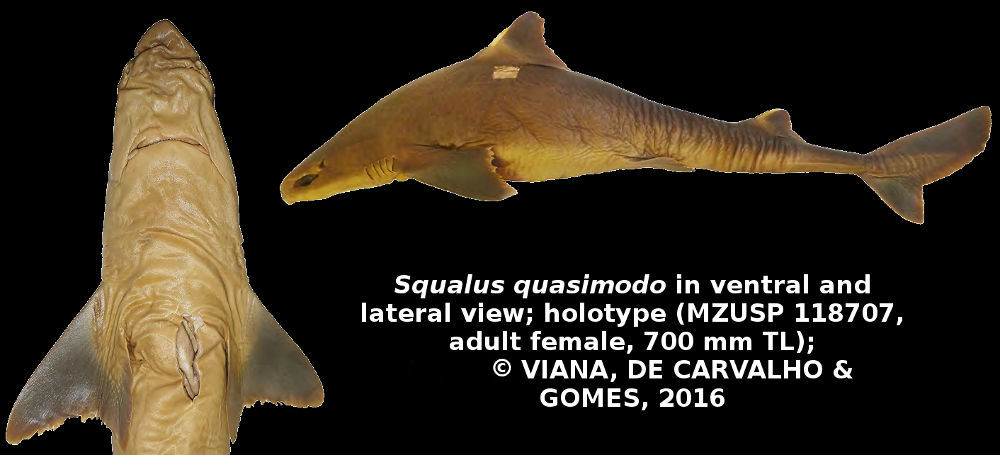Squalus quasimodo
Viana, De Carvalho & Gomes, 2016
Classification: Elasmobranchii Squaliformes Squalidae
Reference of the original description
Taxonomy and morphology of species of the genus Squalus Linnaeus, 1758 from the Southwestern Atlantic Ocean (Chondrichthyes: Squaliformes: Squalidae). Zootaxa, 4133(1), 1–89
Taxonomy and morphology of species of the genus Squalus Linnaeus, 1758 from the Southwestern Atlantic Ocean (Chondrichthyes: Squaliformes: Squalidae). Zootaxa, 4133(1), 1–89
Synonyms / new combinations and misspellings
Squalus cf. quasimodo
Squalus cf. quasimodo
Types
Squalus quasimodo
Holotype: MZUSP: 118707 (formerly, UERJ 1111); Paratype: MCP: 773; UERJ: 1741; UERJ: 1819;
Squalus quasimodo
Holotype: MZUSP: 118707 (formerly, UERJ 1111); Paratype: MCP: 773; UERJ: 1741; UERJ: 1819;
Description :
Citation: Squalus quasimodo Viana, De Carvalho & Gomes, 2016: In: Database of modern sharks, rays and chimaeras, www.shark-references.com, World Wide Web electronic publication, Version 12/2025
Please send your images of "Squalus quasimodo" to info@shark-references.com

Squalus quasimodo in ventral and lateral view; holotype (MZUSP 118707, adult female, 700 mm TL); © Viana, De Carvalho & Gomes, 2016

Squalus quasimodo in ventral and lateral view; holotype (MZUSP 118707, adult female, 700 mm TL); © Viana, De Carvalho & Gomes, 2016
Common names
 Humpback Western dogfish,
Humpback Western dogfish,  cação-bagre-corcunda
cação-bagre-corcunda
 Humpback Western dogfish,
Humpback Western dogfish,  cação-bagre-corcunda
cação-bagre-corcunda
Short Description
Original diagnosis after DE F. VIANA, DE CARVALHO & GOMES, 2016 [24274]: A species of Squalus from the SWAO that can be distinguished from its congeners through a combination of characters: body conspicuously robust and humped dorsally; second dorsal fin upright and markedly tall (its height 4.0%, 4.7%–5.3% TL); first and second dorsal-fin spines elongate (first dorsal-fin spine length 4.3%, 3.3%–4.3% TL; second dorsal-fin spine length 4.4%, 3.9%–4.3% TL), and broad at base (first spine base length 0.9%, 0.7%–1.0% TL; second spine base length 1.0%, 0.8%–0.9% TL); caudal fin with conspicuous rectangular dorsal lobe; and dermal denticles tricuspid, markedly imbricate and broad at crown. Squalus quasimodo sp. nov. differs from S. bahiensis by having a larger pectoral-fin anterior margin length (15.9%, 15.5%–16.0% TL vs. 14.3%, 14.4%–14.5% TL, respectively) and more elongate first dorsal-fin spine (length 4.3%, 3.3%–4.3% TL vs. 2.8%, 2.9%–3.0% TL). Squalus quasimodo sp. nov. has a larger first dorsal fin than S. bahiensis with a greater anterior margin length (11.2%, 10.8%–11.4% TL vs. 10.5%, 10.3%–10.6% TL, respectively) and fin base (length 8.2%, 7.7%–8.5% TL vs. 7.5%, 7.2%–7.3% TL, respectively). Squalus quasimodo sp. nov. is clearly distinct from S. lobularis by having a greater interdorsal distance (26.4%, 24.0%–25.8% TL vs. 22.3%, 21.9%–23.6% TL, respectively).
Original diagnosis after DE F. VIANA, DE CARVALHO & GOMES, 2016 [24274]: A species of Squalus from the SWAO that can be distinguished from its congeners through a combination of characters: body conspicuously robust and humped dorsally; second dorsal fin upright and markedly tall (its height 4.0%, 4.7%–5.3% TL); first and second dorsal-fin spines elongate (first dorsal-fin spine length 4.3%, 3.3%–4.3% TL; second dorsal-fin spine length 4.4%, 3.9%–4.3% TL), and broad at base (first spine base length 0.9%, 0.7%–1.0% TL; second spine base length 1.0%, 0.8%–0.9% TL); caudal fin with conspicuous rectangular dorsal lobe; and dermal denticles tricuspid, markedly imbricate and broad at crown. Squalus quasimodo sp. nov. differs from S. bahiensis by having a larger pectoral-fin anterior margin length (15.9%, 15.5%–16.0% TL vs. 14.3%, 14.4%–14.5% TL, respectively) and more elongate first dorsal-fin spine (length 4.3%, 3.3%–4.3% TL vs. 2.8%, 2.9%–3.0% TL). Squalus quasimodo sp. nov. has a larger first dorsal fin than S. bahiensis with a greater anterior margin length (11.2%, 10.8%–11.4% TL vs. 10.5%, 10.3%–10.6% TL, respectively) and fin base (length 8.2%, 7.7%–8.5% TL vs. 7.5%, 7.2%–7.3% TL, respectively). Squalus quasimodo sp. nov. is clearly distinct from S. lobularis by having a greater interdorsal distance (26.4%, 24.0%–25.8% TL vs. 22.3%, 21.9%–23.6% TL, respectively).
Dentition
Teeth unicuspid, similar in both jaws, alternate, compressed and wide labial-lingually at crown; lower teeth markedly larger and taller than upper teeth; cusp pointed, somewhat elongate and thick, oblique, directed laterally; mesial cutting edge conspicuously convex (straight on lower lateral teeth); mesial heel notched; distal heel rounded; apron short and heavy; two series of functional teeth in upper and lower jaw; tooth rows from 14–14 (14–14 paratypes) in upper jaw and 11–11 (11–11 paratypes) in lower jaw [24274]
Teeth unicuspid, similar in both jaws, alternate, compressed and wide labial-lingually at crown; lower teeth markedly larger and taller than upper teeth; cusp pointed, somewhat elongate and thick, oblique, directed laterally; mesial cutting edge conspicuously convex (straight on lower lateral teeth); mesial heel notched; distal heel rounded; apron short and heavy; two series of functional teeth in upper and lower jaw; tooth rows from 14–14 (14–14 paratypes) in upper jaw and 11–11 (11–11 paratypes) in lower jaw [24274]
Remarks
shark-references Species-ID=14607;
shark-references Species-ID=14607;

















